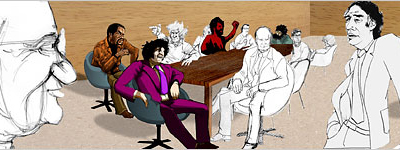
When my brother was in town a few weeks back we spent an afternoon at the Chicago History Museum (née Historical Society) where one wall is dedicated to the events surrounding the 1968 Democratic National Convention. A video tape plays among the ephemera – footage of the protests in Grant Park, the riots in the streets, Daley’s shoot to kill order.
It was just me and one other guy standing alone in front of the exhibit, and before too long he said out loud to no one in particular “I remember that like it was yesterday.” I said “really?” and he said “oh yeah – delegates were throwing ashtrays out the windows of the Congress Park Hotel down at the protesters. You can still see lots on the South Side where businesses burned down during the riots – they’re still empty today.”
I hoped he would say more, but instead we watched for a while longer in silence until he shook his head. “I can’t watch this.” His voice broke as he stepped away. “It was a national disgrace.”
He was gone before I could ask what he meant – did he feel Chicago had disgraced itself in the eyes of the nation? That the nation had disgraced itself by the way it handled the fallout? That the war that sparked it all was the disgrace?
One clip that I didn’t see running at the museum, but did see recently on public television, was a clip of Bobby Seale of the Chicago Eight (which would later devolve into the Chicago Seven) bound and gagged in the courtroom where he stood trial. The judge had ordered it done, because Mr. Seale was making a ruckus in court.
It was horrifying, which may be why our teacher never showed it in Social Studies. I had to wonder when I did see it, just a few months ago, if the judge would have had Mr. Seale bound and gagged if he were a white man.
The point of all this is Brett Morgan’s new movie, Chicago 10, which was recently selected as the opening night feature for the Sundance Film Festival. Mr. Morgan:
has been working on his latest documentary since 2001. In the process he has amassed what he says are 180 hours of 16-millimeter film, about 40 hours of video, 14,000 photographs, more than 200 hours of audio and a 23,000-page court transcript, and has come up with what may be a new kind of nonfiction film: a work of “experiential cinema,” as he chooses to call it, a third of which is animated.…
“Animation came in for a number of reasons,” he said. “There were certain moments that weren’t on film, especially the trial. We needed a way to show what was happening in the courtroom. We could have done it in re- enactments, or though talking heads, or we could have had courtroom drawings panned and scanned. But I thought animation would have served as commentary on the trial; Jerry Rubin called it a ‘cartoon show,’ and when I read that quote, the bells went off.”
Bringing a Political Trial to Animated Life, NYT 26 Nov 2006
The New York Times ran a piece on the movie in today’s paper -- no word yet on who’s distributing it. It’ll be interesting to see if they wait to release it until the 2008 Elections are in full swing.






No comments:
Post a Comment